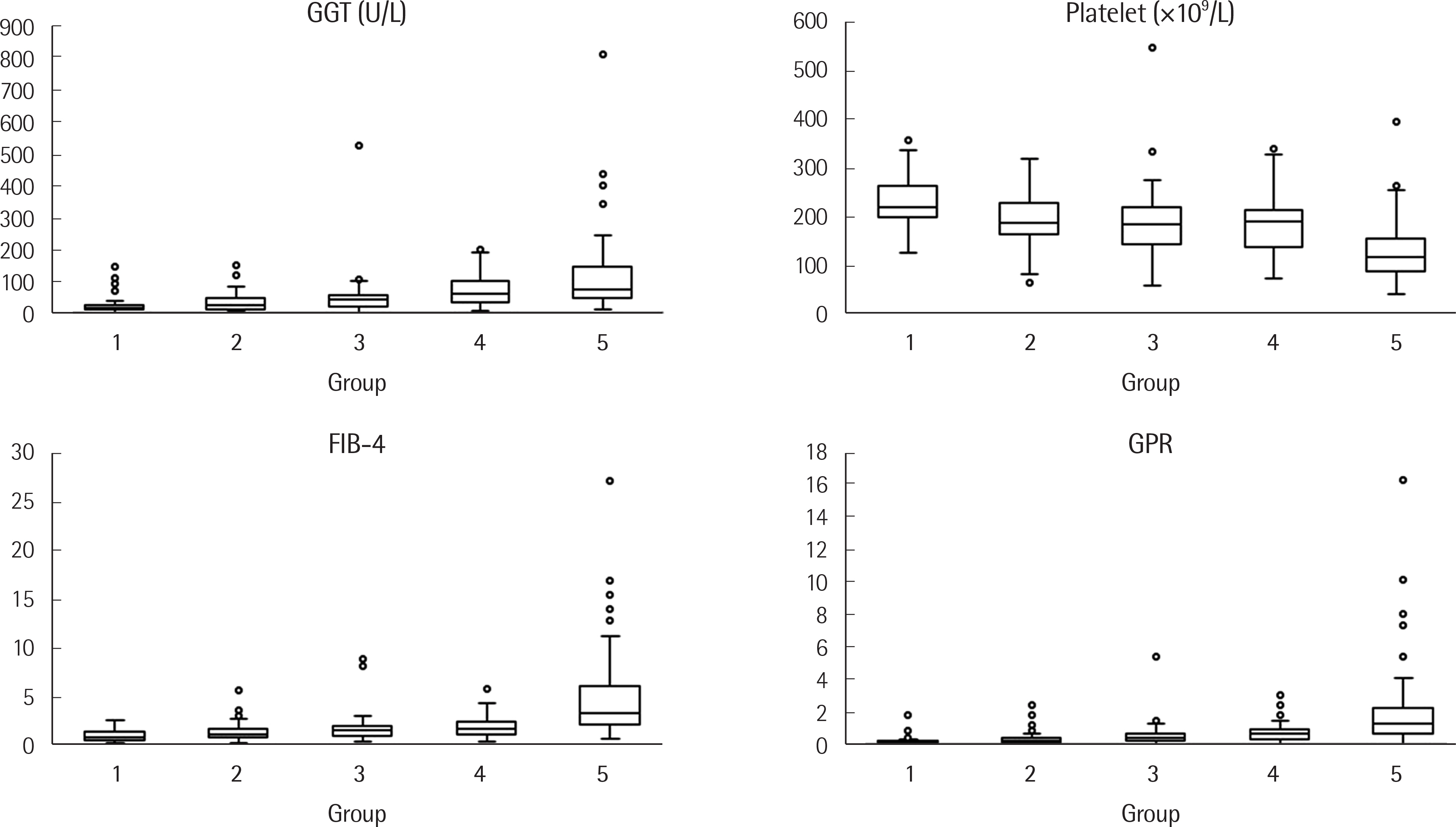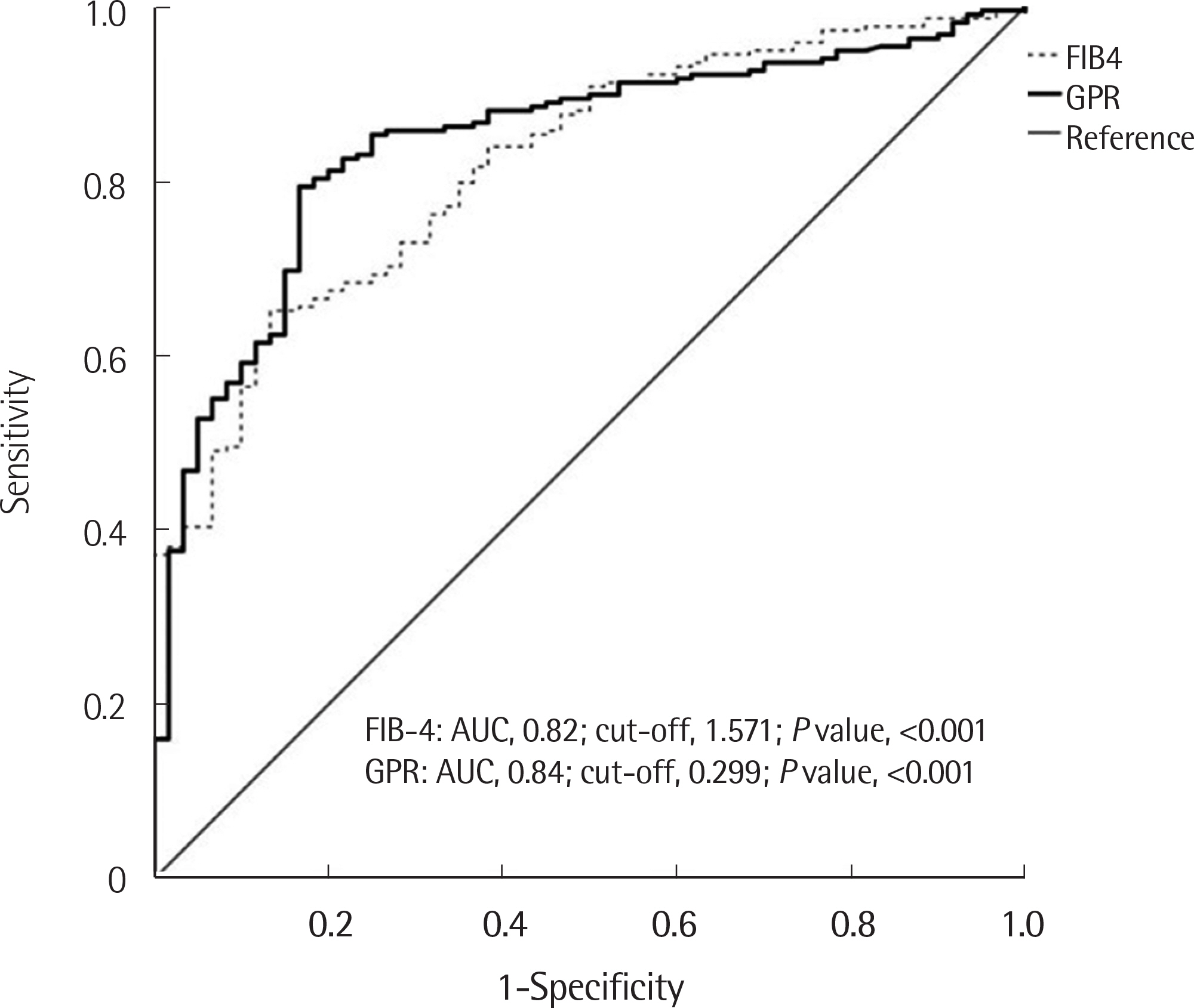Lab Med Online.
2019 Jul;9(3):153-160. 10.3343/lmo.2019.9.3.153.
Evaluation of Noninvasive Liver Fibrosis Blood Markers in Patients with Chronic Hepatitis B and Hepatitis C
- Affiliations
-
- 1Department of Laboratory Medicine, Yonsei University Wonju College of Medicine, Wonju, Korea. cello425@yonsei.ac.kr
- KMID: 2450840
- DOI: http://doi.org/10.3343/lmo.2019.9.3.153
Abstract
- BACKGROUND
Liver fibrosis evaluation is an important issue in chronic liver disease patients. We aimed to develop noninvasive liver fibrosis biomarkers based on transient elastography (TE, FibroScan®) through retrospective review of clinicopathological data.
METHODS
We recruited 278 chronic hepatitis B patients who underwent Fibroscan and HBV DNA testing. A total of 115 HBeAg-positive and 159 HBeAg-negative chronic hepatitis B patients were analyzed. A total of 100 hepatitis C patients were analyzed. Successful fibroscan data, gamma-glutamyl transferase (GGT) to platelet ratio (GPR), platelet count, AST, ALT, international normalized ratio of prothrombin time, total cholesterol, triglycerides, bilirubin, mean platelet volume, AST to platelet ratio index, fibrosis index based on four factors (FIB-4), neutrophil to lymphocyte ratio (NLR), and NLR to platelet ratio were analyzed to determine the new noninvasive markers for assessing liver fibrosis.
RESULTS
Elevated GPR (OR=9.1, P=0.011) and FIB-4 (OR=2.3, P=0.01) were associated with greater risk of liver fibrosis in chronic hepatitis B patients. FIB-4 (OR=6.04, P=0.005) was a risk factor for liver fibrosis in HBeAg-positive patients. FIB-4 (OR=2.371, P=0.015) and GPR (OR=33.78, P=0.003) were liver fibrosis risk factor in HBeAg-negative patients. In chronic hepatitis C patients, GGT (OR=1.033, P=0.002), triglyceride (OR=−0.990, P=0.038) and FIB-4 (OR=3.499, P=0.006) showed statistical significances. The AUCs were 0.816 in FIB-4 (P<0.001) and 0.849 in GPR (P<0.001).
CONCLUSIONS
FIB-4 and GPR may be useful blood markers for assessing liver fibrosis in chronic hepatitis B and hepatitis C patients. Further well-designed prospective study is required to validate these noninvasive blood markers in clinical practice.
Keyword
MeSH Terms
-
Area Under Curve
Bilirubin
Biomarkers
Blood Platelets
Cholesterol
DNA
Elasticity Imaging Techniques
Fibrosis
Hepatitis B
Hepatitis B, Chronic*
Hepatitis C*
Hepatitis C, Chronic
Hepatitis*
Hepatitis, Chronic*
Humans
International Normalized Ratio
Liver Cirrhosis*
Liver Diseases
Liver*
Lymphocytes
Mean Platelet Volume
Neutrophils
Platelet Count
Prospective Studies
Prothrombin Time
Retrospective Studies
Risk Factors
Transferases
Triglycerides
Bilirubin
Biomarkers
Cholesterol
DNA
Transferases
Triglycerides
Figure
Reference
-
References
1. Bravo AA, Sheth SG, Chopra S. Liver biopsy. N Engl J Med. 2001; 344:495–500.
Article2. Coco B, Oliveri F, Maina AM, Ciccorossi P, Sacco R, Colombatto P, et al. Transient elastography: a new surrogate marker of liver fbrosis in-fuenced by major changes of transaminases. J Viral Hepat. 2007; 14:360–9.3. Colombo S, Belloli L, Buonocore M, Jamoletti C, Zaccanelli M, Badia E, et al. True normal liver stiffness measurement (LSM) and its determinants. Hepatology. 2009; 50:741A–2A.4. Foucher J, Chanteloup E, Vergniol J, Castéra L, Le Bail B, Adhoute X, et al. Diagnosis of cirrhosis by transient elastography (FibroScan): a prospective study. Gut. 2006; 55:403–8.
Article5. Friedrich–Rust M, Ong MF, Martens S, Sarrazin C, Bojunga J, Zeuzem S, et al. Performance of transient elastography for the staging of liver fbrosis: a metaanalysis. Gastroenterology. 2008; 134:960–74.6. Kim SU, Choi GH, Han WK, Kim BK, Park JY, Kim DY, et al. What are ‘true normal'liver stiffness values using FibroScan?: a prospective study in healthy living liver and kidney donors in South Korea. Liver Int. 2010; 30:268–74.7. Pinzani M, Vizzutti F, Arena U, Marra F. Technology Insight: noninvasive assessment of liver fbrosis by biochemical scores and elastography. Nat Clin Pract Gastroenterol Hepatol. 2008; 5:95–106.8. Arena U, Vizzutti F, Corti G, Ambu S, Stasi C, Bresci S, et al. Acute viral hepatitis increases liver stiffness values measured by transient elastography. Hepatology. 2008; 47:380–4.
Article9. Sagir A, Erhardt A, Schmitt M, Häussinger D. Transient elastography is unreliable for detection of cirrhosis in patients with acute liver damage. Hepatology. 2008; 47:592–5.
Article10. Marcellin P, Ziol M, Bedossa P, Douvin C, Poupon R, De Lédinghen V, et al. Non‐invasive assessment of liver fbrosis by stiffness measurement in patients with chronic hepatitis B. Liver Int. 2009; 29:242–7.11. Lok AS and McMahon BJ. Chronic hepatitis B: update 2009. Hepatology. 2009; 50:661–2.
Article12. Kim SU, Seo YS, Cheong JY, Kim MY, Kim JK, Um SH, et al. Factors that affect the diagnostic accuracy of liver fbrosis measurement by Fibroscan in patients with chronic hepatitis B. Aliment Pharmacol Ther. 2010; 32:498–505.13. Kim BK, Kim DY, Park JY, Ahn SH, Chon CY, Kim JK, et al. Validation of FIB-4 and comparison with other simple noninvasive indices for predicting liver fbrosis and cirrhosis in hepatitis B virus-infected patients. Liver Int. 2010; 30:546–53.14. Liu DP, Lu W, Zhang ZQ, Wang YB, Ding RR, Zhou XL, et al. Comparative evaluation of GPR versus APRI and FIB-4 in predicting different levels of liver fbrosis of chronic hepatitis B. J Viral Hepat. 2018; 25:581–9.15. Lemoine M, Shimakawa Y, Nayagam S, Khalil M, Suso P, Lloyd J, et al. The gamma-glutamyl transpeptidase to platelet ratio (GPR) predicts signifcant liver fbrosis and cirrhosis in patients with chronic HBV infection in West Africa. Gut. 2016; 65:1369–76.16. Lin ZH, Xin YN, Dong QJ, Wang Q, Jiang XJ, Zhan SH, et al. Performance of the aspartate aminotransferase-to-platelet ratio index for the staging of hepatitis C-related fbrosis: an updated metaanalysis. Hepatology. 2011; 53:726–36.17. Vallet-Pichard A, Mallet V, Nalpas B, Verkarre V, Nalpas A, Dhalluin-Venier V, et al. FIB-4: an inexpensive and accurate marker of fbrosis in HCV infection. comparison with liver biopsy and fbrotest. Hepatology. 2007; 46:32–6.18. Li J, Verhaar AP, Pan Q, de Knegt RJ, Peppelenbosch MP. Serum levels of caspase-cleaved cytokeratin 18 (CK18-Asp396) predict severity of liver disease in chronic hepatitis B. Clin Exp Gastroenterol. 2017; 10:203–9.
Article19. Rosenberg WM, Voelker M, Thiel R, Becka M, Burt A, Schuppan D, et al. Serum markers detect the presence of liver fbrosis: a cohort study. Gastroenterology. 2004; 127:1704–13.20. Kuno A, Ikehara Y, Tanaka Y, Ito K, Matsuda A, Sekiya S, et al. A serum “sweet-doughnut” protein facilitates fbrosis evaluation and therapy assessment in patients with viral hepatitis. Sci Rep. 2013; 3:1065.
Article21. Nishikawa H, Takata R, Enomoto H, Yoh K, Kishino K, Shimono Y, et al. Proposal of a predictive model for advanced fbrosis containing Wisteria foribunda agglutinin-positive Mac-2-binding protein in chronic hepatitis C. Hepatol Res. 2017; 47:E74–84.22. Abe M, Miyake T, Kuno A, Imai Y, Sawai Y, Hino K, et al. Association between Wisteria foribunda agglutinin-positive Mac-2 binding protein and the fbrosis stage of non-alcoholic fatty liver disease. J Gastroenterol. 2015; 50:776–84.23. Umemura T, Joshita S, Sekiguchi T, Usami Y, Shibata S, Kimura T, et al. Serum Wisteria foribunda agglutinin-positive Mac-2-binding protein level predicts liver fbrosis and prognosis in primary biliary cirrhosis. Am J Gastroenterol. 2015; 110:857–64.24. Nishikawa H, Enomoto H, Iwata Y, Hasegawa K, Nakano C, Takata R, et al. Clinical signifcance of serum Wisteria floribunda agglutinin positive Mac-2-binding protein level and high-sensitivity C-reactive protein concentration in autoimmune hepatitis. Hepatol Res. 2016; 46:613–21.25. Yamada N, Sanada Y, Tashiro M, Hirata Y, Okada N, Ihara Y, et al. Serum Mac-2 binding protein glycosylation isomer predicts grade F4 liver fbrosis in patients with biliary atresia. J Gastroenterol. 2017; 52:245–52.
- Full Text Links
- Actions
-
Cited
- CITED
-
- Close
- Share
- Similar articles
-
- Current role of transient elastography in the management of chronic hepatitis B patients
- The Performance of Serum Biomarkers for Predicting Fibrosis in Patients with Chronic Viral Hepatitis
- Clinical Implications of Shear Wave Elastography in Patients with Chronic Hepatitis B
- Hepatitis Activity and Fibrosis of Chronic Hepatitis
- Viral Serologic Markers in Patients with Acute and Chronic Liver Diseases



